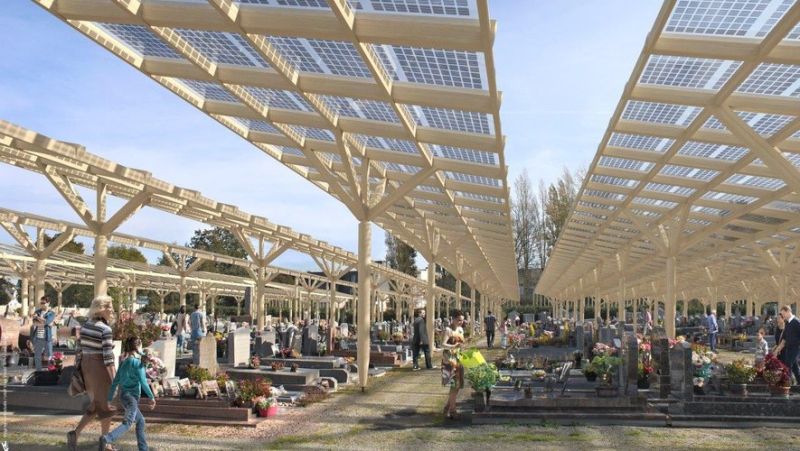The municipal cemetery will soon be able to produce solar energy

5 000 panneaux photovoltaïques seront installés. – Ville de Saint-Joachim
In Saint-Joachim, in Loire-Atlantique, photovoltaic panels will soon be installed according to design. A residents’ association was even formed to help the municipality implement this citizen project.
The initial idea was to cover the cemetery of Saint-Joachim (Loire-Atlantique) to limit flooding in winter and also collect rainwater, particularly to water the neighboring sports ground subjected to severe tests in the summer. But the town, located in the heart of the Brière Regional Natural Park (north of Saint-Nazaire), saw bigger things. Why not cover the cemetery with panels ? The idea caught on. Quickly… Indeed, since 2008, the municipality has already embarked on a photovoltaic development policy. Neither one nor two, the Brièr’Energie association is made up of around fifteen people.
"The objective was to help the municipality find willing residents to finance their purchase", recalls Philippe Renoux, its vice-president. Ultimately, the calendar is a godsend: it is the 7% more property tax that will contribute."The Briérons are financing the purchase of the panels via the municipality, and will recover their tax increase in the form of electricity redistributed on a collective self-consumption loop."
5,000 panels installed
If all households equipped with a Linky meter can connect to it, around 500 households (or “delivery points” according to the established jargon) are now ;rsquo;now manifested. "We are counting on 1,000", assures Philippe Renoux, who has been strengthening his communication since the deployment of the prototype in May . The opportunity to test the techniques (and to reassure yourself too), before launching the call for tenders. What is emerging is a coverage of photovoltaic shade structures, around 5,000 panels, over 6,000 square meters of usable surface area.
"It will be almost tailor-made!", specifies Denis Salaün, the city's financial director. Here, the ground is corrugated, impossible to level it, and you will have to be careful to organize the space without damaging it. "In a cemetery, there is no room for error. It's better to take another month, but do things well…" The posts, which will support the shade houses, will be slipped into the piles driven 15 meters deep. And they will be made of glued laminated wood, "for more harmony".
In this project, the City, owner of the power plant, is the electricity supplier. The association is the "organizing legal entity". It is she who makes the link between inhabitant, production, and distribution. To do this, it was necessary to develop, with the help of the company Enogrid, a tool capable of measuring consumption to ensure equitable redistribution.
The cemetery could produce 1.4 million kilowatt hours
Each year, the cemetery could produce 1.4 million kilowatt hours (kWh). "This is not a panacea, the inhabitants of Saint-Joachim will continue to pay for electricity", nuance Denis Salaün, who specifies that here per year, we consume around 11 megawatt hours (MkWh). But if we add the energy produced by the shades of the parking lot which adjoins the performance hall, today operated by a private company, “We could manage to cover 30% of the municipality's total consumption”.
30% of the municipality's total consumption
“The cemetery project is the culmination of our policy of developing photovoltaics on public buildings”, says Jacques Cochy, deputy for the environment. Over the past fifteen years, eight buildings have been covered with panels: schools, post office, sports halls, technical services… “In short, everything that was well exposed!”, smiles Denis Salaün. And the initial objective: “to generate revenue and secure the future” has been achieved.
Today, the City produces twice as much electricity as it consumes! "All our producer buildings are connected in the same self-consumption network. Only the first equipped ones still operate in direct sales, because the decrees, in force today, did not exist at the beginning…" Since 2023, the Energy Regulatory Commission (CRE) allows, upon exemption, self-consumption at the same station within a radius of twenty kilometers.
Towards energy autonomy
So, if in the past the initiative may have surprised you (even the councilor of the time was cautious), today people come from all over France to discover, on the ground, the model of this small town on the road to energy autonomy. And economical too… "All investments made so far, i.e. around 2 million euros, have been self-financed by productions, in no case by taxes!", insists Denis Salaün. Note that the project is supported by the Récit citizen association and by the Fondation de France Grand-Ouest.
As for residents too, we generally trust this municipality "which seems to know how to do it"… The project did not raise any real opposition among the population, except in the municipal council (where, last November, the three opposition elected officials voted against). And for good reason, out of the 4,200 inhabitants of the town, the Brièr’Energie association today has 450 members, the majority of whom are residents. Crossed at the entrance to the cemetery, this septuagenarian has of course heard about the project, which should see the light of day by 2025, but "without imagining it, nor commit to that much"…
Resolutely voluntary, Philippe Renoux summarizes the philosophy of his association: "This project has a double objective: to limit the bill, but also to redirect the production of’ electricity at other times of the day, and learn how to use it best. Being responsible, the future demands it from us."




